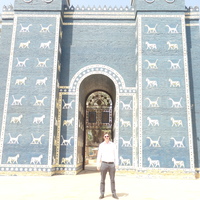Rients de Boer
Leiden University, Centre for Global Heritage and Developement, Department Member
What do we know about Hammurabi's family? This article looks at the familiy members of his dynasty known from currently published cuneiform texts.
Research Interests:
Five micro-studies on Isin’s Old Babylonian kings and Isin history are presented together with an updated list of Isin year names.
Research Interests:
In this article two Ur III administrative texts (tablet+envelope) are presented in transliteration and translation. They were scanned with an X-ray micro CT-scanner to reveal the contents of the tablets in their envelopes.
Research Interests:
In this review article, the 221 Old Babylonian letters published by Andrew George (2018) in CUSAS 36 are discussed. They stem mostly from southern Iraq covering a period of time between ca. 1880 and 1712 BCE. The most interesting group is... more
In this review article, the 221 Old Babylonian letters published by Andrew George (2018) in CUSAS 36 are discussed. They stem mostly from southern Iraq covering a period of time between ca. 1880 and 1712 BCE. The most interesting group is the Sumu-El correspondence dated between ca. 1870 and 1865 BCE of which the historical and broader geo-political context during the Isin-Larsa wars is explored. As the provenance of these letters Raḫābum is proposed, an as of yet still not located town in the Larsa kingdom. For the other letters, not belonging to the Sumu-El group, efforts are made to group them together and link them to other text groups such as the Ipqu-Sîn dossier. In addition, it is proposed that a group of letters form a coherent dossier revolving around the Rīm-Sîn (1822-1773 BCE) era military officer Lipit-Ištar. The article ends with additional comments on selected letters, proposing different readings, notes, and additional bibliographical references.
Research Interests:
Basilophoric personal names are names that contain the name of a king as an element. Examples are "Hammurabi is my god", "Samsī-Addu is my trust", or "Išbi-Erra is the life of the country". This contribution studies the occurrence of... more
Basilophoric personal names are names that contain the name of a king as an element. Examples are "Hammurabi is my god", "Samsī-Addu is my trust", or "Išbi-Erra is the life of the country". This contribution studies the occurrence of basilophoric personal names during the Old Babylonian (OB) period (about 2003-1595 BCE) from a social and political perspective.
Research Interests:
This article studies the lives of two men pivotal in the history of (Old Babylonian) Babylon: Sumu-abum and Sumu-la-El. Sumu-abum was an Amorite tribal and military leader who led groups of Amorite warriors between ca. 1890 and 1860 BCE.... more
This article studies the lives of two men pivotal in the history of (Old Babylonian) Babylon: Sumu-abum and Sumu-la-El. Sumu-abum was an Amorite tribal and military leader who led groups of Amorite warriors between ca. 1890 and 1860 BCE. He managed to conquer large swaths of northern Babylonian and the Lower Diyala region. In the wake of these conquests, numerous small Amorite kingdoms were set up by his subordinates. The most important one was Sumu-la-El (1880-1845 BCE), who founded the First Dynasty of Babylon. After Sumu-abum's death, Sumu-la-El subjugated several other petty kings in Babylon's vicinity and built a string of fortresses around his territory. Through his actions he formed the core of the Babylonian kingdom.
Research Interests:
Research Interests:
Research Interests:
During the early Old Babylonian period (ca. 2000-1850 BC) several Amorite rulers asserted themselves in Northern Babylonia and the Diyala region. This contribution takes a look at the Amorite tribes settling in these regions and the way... more
During the early Old Babylonian period (ca. 2000-1850 BC) several Amorite rulers asserted themselves in Northern Babylonia and the Diyala region. This contribution takes a look at the Amorite tribes settling in these regions and the way in which they were tribally organized. The Amorite tribes and tribal structures changed constantly. This change is evident from the comparisons with the later dated textual material from Mari. Sumu-abum was an influential Amorite leader. From a largely unpublished archive we know that around 1880 BC Sumu-abum played a prominent role in some kind of pan-tribal assembly. It is possible that his death eventually paved the way for Babylon's conquests under king Sumu-la-El.
Research Interests:
Research Interests:
Research Interests:
Research Interests:
Research Interests:
Research Interests:
Research Interests:
Research Interests:
Research Interests:
Research Interests:
Research Interests:
Research Interests:
Review of Sasson 2017 (soft cover) From the Mari Archives, an Anthology of Old Babylonian Letters
Research Interests:
Review of Van de Mieroop 2016: Philosophy before the Greeks
Research Interests:
Published on the Bryn Mawr Classical Review website:
http://bmcr.brynmawr.edu/2018/2018-02-29.html
http://bmcr.brynmawr.edu/2018/2018-02-29.html
Research Interests:
Research Interests:
Research Interests:
Research Interests:
Research Interests:
Research Interests:
Research Interests:
Research Interests:
Research Interests:
Research Interests:
Research Interests:
Research Interests:
Research Interests:
Research Interests:
Opinion article in Dutch Newspaper NRC: https://www.nrc.nl/nieuws/2018/02/23/archeologie-en-oude-talen-moeten-klein-kunnen-blijven-a1593363
